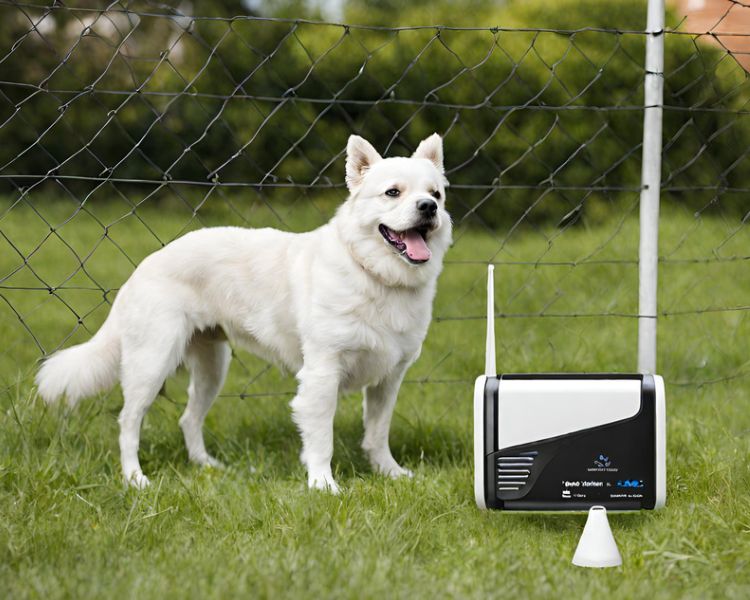How Wireless Dog Fences Work
Wireless dog fences, also known as invisible fences, work by sending signals from a transmitter to a dog’s collar. The transmitter connects to a standard household power outlet and sends a radio signal through a wire that is buried just below the ground around the perimeter of a yard (https://dogfence.co.uk/canine-advice/wireless-dog-fence-the-truth/). This creates an invisible boundary for the dog. The collar worn by the dog picks up the signal from the buried wire. As the dog approaches the boundary, the collar first emits a warning beep, then gives a mild static correction if they continue moving toward the boundary (https://www.angi.com/articles/what-you-need-know-about-electric-dog-fencing.htm). This trains the dog to stay within the designated yard area.
The static correction from the collar conditions the dog to remain inside the boundary, without the need for a physical fence or barrier. This allows the owners to install an “invisible” fence around their property using only the buried wire and special collar.
Loss of Power Means Loss of Signal
Wireless dog fences rely on electricity to function properly. The system’s transmitter connects to a standard power outlet in order to broadcast a radio signal through the buried wire that defines the containment area. Without power, the transmitter cannot send this signal through the wire (source). As a result, the collar worn by the dog does not receive the signal and thus cannot administer any warning beeps or static correction if the dog approaches the boundary (source).
This means that if the power goes out for any reason, the wireless fence temporarily loses the ability to keep the dog contained. Without receiving the boundary signal, dogs can easily wander past the buried wire without realizing they are leaving the designated containment area. Power outages therefore pose a significant risk of pets escaping their yards if the outage lasts for an extended period of time.
Consequences of Losing the Boundary

One of the biggest risks when a wireless dog fence loses power is that dogs may wander past their normal boundaries. According to the PetSafe wireless fence manual, “The Wireless System is designed to work as a containment system by keeping your pet in the Boundary Area you set. Upon power loss or battery failure, your pet’s Receiver Collar will no longer be containing your pet.”
Without the wireless boundary being enforced by the collars, dogs who are used to staying within the set limits may take the opportunity to explore further. This can lead to potential escapes, with dogs getting lost or entering into dangers from cars, other animals, or unfamiliar people. As PetSafe notes, power loss means there is nothing actively keeping your dogs contained in the normal yard or area.
Owners will want to be aware of any downed fences or open gates during power losses. And even well-trained dogs may be tempted to test the non-working boundaries out of curiosity when the collars stop providing feedback. Taking preventative steps is key to avoiding the risks if electricity goes out.
Preventing Escapes
Once you realize the power is out and your wireless dog fence is not operational, it’s important to take steps to prevent your dog from escaping the boundary area. Here are some tips:
Notify any family members or roommates that the wireless fence is down. Ask them to keep a close eye on the dog when letting them outside, and restrict the dog to leashed walks only. Supervise the dog at all times until power returns.
You can also set up a temporary physical barrier or fencing as a backup. For example, place a tall pet gate across any exits leading out of the house or yard. Or use exercise pens to block off certain areas. Make sure the backup fencing is secure and stable enough that the dog can’t jump or push through it (FOCUSER).
Leashing your dog anytime they go outside is the safest option when the wireless fence loses power. Take them out to potty and for walks only when they are securely leashed. This prevents any chance of them wandering off the property.

Using a Backup Power Source
Most modern wireless dog fence systems come equipped with a backup battery in the transmitter that will continue powering the fence if electricity goes out. According to OkMyPet, their transmitters have a built-in 1000mAh backup battery that provides up to 10 hours of power. This gives owners a lengthy window to restore power or retrieve their dog before the battery dies.
For even longer outages, connecting a generator to the transmitter can extend the backup power. Gasoline generators offer the most runtime, though loud noise may disturb dogs. Quieter inverter generators provide cleaner power but shorter runtimes on a tank of gas. Following manufacturer guidelines on powering the transmitter with a generator is important to avoid damage.
Installing a dedicated backup generator just for the dog fence ensures power but involves a major investment. Battery backups only provide temporary power, so pet owners in outage-prone areas should also have a plan to transition to physical fencing if extended blackouts occur.
Switching to a Physical Fence
If your wireless dog fence frequently loses power or you want a more permanent containment solution, it may be time to install a physical fence around your yard. Wooden privacy fences and chain link fences provide a clear physical barrier that contains your dog without the need for electricity.
The upfront cost of installing a wood or chain link fence is higher than a wireless system. However, a physical fence provides a permanent boundary that never loses power and doesn’t require the maintenance and battery changes of a wireless system. Dogs quickly learn that they cannot pass through a physical fence.
Installing a fence around the entire perimeter of your property ensures your dog has no chance of escaping, versus relying on a wireless barrier that could potentially fail. While more work upfront, a wood or chain link fence brings peace of mind knowing your dog is securely contained at all times.

Trying Other Containment Options
If your wireless fence is not an option when the power goes out, you’ll need alternate ways to contain your dog safely in your yard. Here are some effective options to consider:
A tie-out system uses a tether attached to a lead that allows your dog to roam within a fixed area and prevents escape. Look for tie-outs designed specifically for dogs, with swivels and durable, chew-resistant cables. Ensure your dog has access to shade, shelter, food and water while on the tie-out.[1]
You can also use a kennel or dog run to contain your dog when you’re not home during a power outage. Be sure the kennel is large enough for your dog to stand, turn around, and lie down comfortably. Place it in a shaded area and provide fresh water. Never leave your dog in a kennel for prolonged periods without monitoring.[2]
Finally, training your dog on verbal cues like “stay” and “come” and reinforcing boundary lines can help maintain control when your wireless fence is down. Work on obedience regularly so your dog listens without the need for a correction from the collar.[1] With patience and positive reinforcement, many dogs learn to respect limits even without a physical barrier in place.
Preparing for Future Power Losses
When thinking ahead to potential power outages, pet owners using wireless dog fences have a few options to keep their dogs safely contained. As recommended in this forum thread, having a backup power source ready is a key preparation step. This could involve keeping spare batteries on hand for the dog’s collar, investing in a backup battery specifically designed for the wireless fence, or having a portable power station or generator available.
Pet owners can also create an emergency confinement area within their home or garage to easily secure their dog if the wireless fence loses power. This could be a crate, exercise pen, or closed-off room without access to exits. Training the dog to go to this area on command is recommended, so the pet knows where to go if the owner needs to suddenly contain them during an outage.

Taking some time to train dogs what to do in a power loss situation can go a long way in keeping them safely confined. Practice routines of calling the dog inside, crating or penning them, and rewarding calm behavior can make it easier for both owner and pet if the wireless fence unexpectedly loses power.
When Power Might Go Out
There are a few common causes for power outages that can impact wireless dog fences. The most frequent cause of outages is severe storms. High winds can damage power lines and trees, disrupting service. Ice storms can also overload lines and equipment with heavy ice accumulation. Other weather events like heat waves, floods, and snowstorms put strain on the electrical grid as well. According to Energized by Edison, storms account for around 60% of all power outages in the United States.
Planned maintenance and utility work is another reason power might go out. Utilities may interrupt service to upgrade equipment, replace lines, or perform repairs. These planned outages are usually temporary and restored quickly, but can impact wireless dog fence signals. Accidents and equipment failures can also trigger unplanned outages. Things like car accidents, animal interference, lightning strikes, and mechanical issues can damage infrastructure and require urgent repairs.
Knowing the main causes of power disruptions can help dog owners prepare for potential loss of perimeter control from their wireless fences. Monitoring weather forecasts, utility notifications, and outage reports can provide advance notice in many cases.
Sources:
https://energized.edison.com/stories/8-common-causes-of-outages
https://taraenergy.com/blog/power-outages-101-what-causes-them/
Staying Informed About Outages
Knowing when and where outages may occur can help you prepare in advance. Here are some ways to stay updated on potential power losses:
Sign up for email or text alerts from your utility company. Most providers offer notification services that can send you messages about planned or unplanned outages in your area. This allows you to get real-time updates and time estimates for restoration.
Regularly check the weather forecast, especially during severe weather like storms, heatwaves or winter weather. Power lines and infrastructure can be vulnerable during extreme conditions, so pay attention to any warnings.
Monitor your utility company’s website and social media pages. They usually post outage maps, updates and FAQs when widespread interruptions occur. Following their channels provides straightforward information direct from the source.
Knowing about outages as soon as possible lets you take preventative steps to keep your pets safe and comfortable if the wireless fence system loses power.[1]
